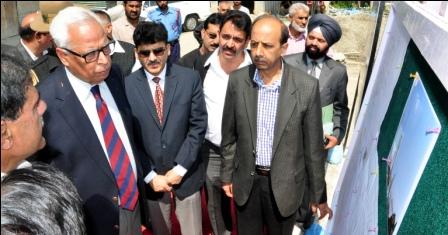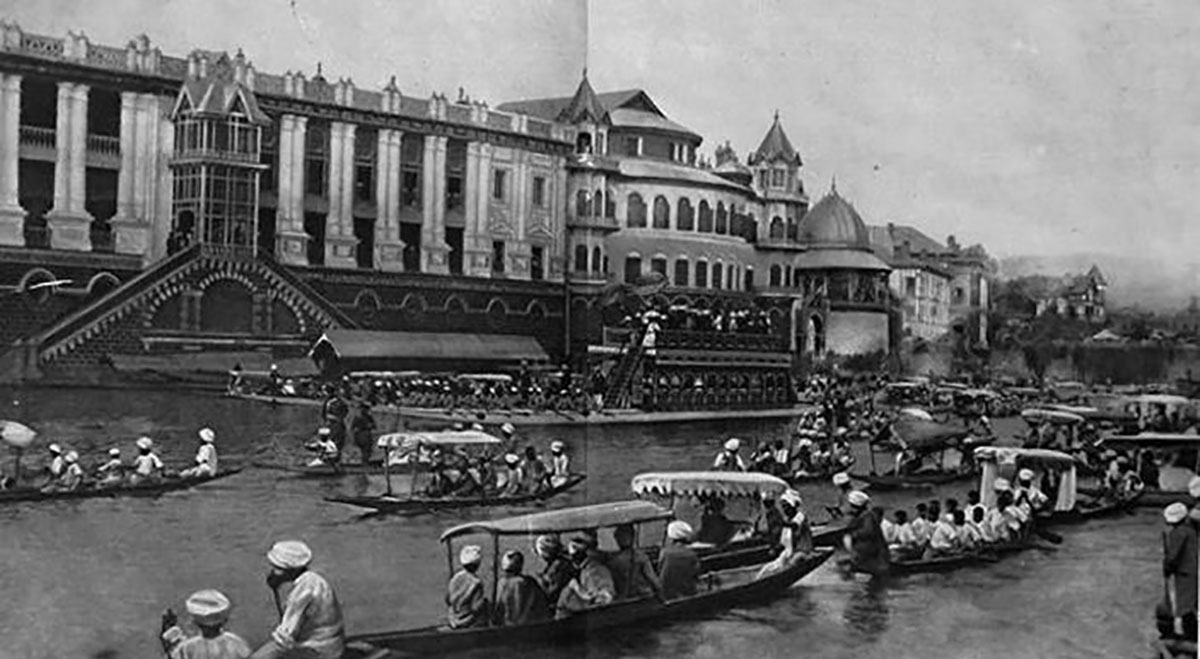by Khalid Bashir Ahmad
In January 2013, when the then Secretary Jammu and Kashmir Academy of Art, Culture and Languages invited the then Minister for Culture to the foundation laying ceremony of the Tehzeeb Mahal at Srinagar, the latter was like, “At Srinagar…Why not at Jammu?”

January 22, 2013: Chief Minister of Jammu and Kashmir, Omar Abdullah, lays the foundation stone of the Rs 72 crore Tehzeeb Mahal near the Tourist Reception Centre in Srinagar. Five years and an expenditure of Rs 50 million later, Chief Minister Mehbooba Mufti, heading a coalition government with the Bhartiya Janta Party (BJP), scraps the project and decides to offer the landholding to the JK Bank whose Corporate Headquarter is located close to the project site.
The Central Committee of the Academy, headed by Ms Mufti, met in Srinagar on May 14, 2018. Agenda Item 30 pertained to the under-construction project of the Tehzeeb Mahal. According to the proposal placed before the Committee, “[D]uring informal discussions the Hon’ble Chief Minister desired to revisit the project and explore the possibility of transferring ownership to some Government Department in lieu of a commensurate sum of compensation/alternative site.” The Committee decided that “the landholding be offered to J&K Bank against a lump sum amount which shall then be utilized by the JKAACL [Academy] for development of infrastructure.”
The proposal left nothing to speculate on whose instance it was cleared without any objection from any member. According to one participant, the government argued that it had no money to carry out the project while the Chief Minister reportedly referred to an ‘earlier decision’ of transferring the land to the JK Bank. However, no official order or document to that effect was placed before the Committee.
As a matter of record, the Committee that took the decision to shut down the Tehzeeb Mahal project comprised, besides the Chief Minister Mehbooba Mufti, Minister for Public Works and Culture, Nayeem Akhtar, Principal Secretary Finance, Navin Chowdhary, Principal Secretary to CM, Rohit Kansal, Secretary Information, Sarmad Hafeez, Secretary Culture, Mohammad Saleem Sheeshgar and Secretary Academy, Aziz Hajni who, as Member Secretary, piloted the proposal. Among non-official members present in the meeting were Ayash Arif, TS Batra, Shad Ramzan, Abhay Rustum Sopori and Phunsokh Ladakhi.
Conceived And Abandoned
Conceived as the nucleus of cultural activities, the features of the Tehzeeb Mahal included auditorium with a seating capacity of 600, Folk Replica Centre, Art Gallery, Intimate Theatre Studio with a seating capacity of 200, Auditorium Balcony, two Exhibition Halls, Handicrafts Display Room, Library and Conference Hall, Heritage Museum, Open Air Theatre and Sculpture Garden. The project was to be completed in 39 months. It goes without saying that the aesthetically designed building, as can be appreciated from the image of the design, would have added to the beauty of the skyline, besides being a centre of attraction for people and tourists for its easily accessible location. The proposed 3-storeyed building was designed to have a traditional architecture with ‘state-of-the-art facilities and special finishes in tune with local heritage architecture’ like Maharaji bricks, deji dewari look, devri stone cladding, khatamband ceiling, pinjra and jaffri work, paper machie and sozni work on walls and log bridge and heritage fort wall.

On January 22, 2013, when the foundation stone of the project was laid, there was an air of expectancy. An official handout released on the occasion predicted that “Jammu and Kashmir’s rich art and culture will soon have a new and befitting address in the multi-facility Tehzeeb Mahal.” Omar Abdullah claimed that the multipurpose cultural centre would be “the hub of cultural activities in Kashmir, besides showcasing the State’s rich heritage and turning into a major tourist attraction.” Importantly, he assured that “money would never be a problem for the completion of the project within the stipulated time of 39 months.” Minister of State for Culture, Sajjad Ahmad Kitchloo, announced that he had adopted the Tehzeeb Mahal as “my dream project and I will personally monitor its completion in time.” On behalf of writers and artists of Kashmir, Rehman Rahi, prominent poet and the only recipient of Gyanpeeth Award from Jammu and Kashmir, thanked the Chief Minister for his “keen interest in the construction of the Tehzeeb Mahal.” These reassuring voices lifted the mood of Kashmir’s artists and writers who had lost hope of a promised cultural centre coming up in the Valley after several aborted attempts to execute the project during the previous several decades. The Tehzeeb Mahal, they believed was jinxed for long and here it seemed that the jinx was finally broken. Sadly, that was not to be.
A 1958 Idea
The Tehzeeb Mahal is a long story of ground-breaking ceremonies, earmarking existing building complexes and long interludes in between. The project is believed to have been conceived soon after the establishment of the Jammu and Kashmir Academy of Art, Culture and Languages set up in 1958. The Academy was set up under Section 146 of the (now scrapped) Constitution of Jammu & Kashmir, “to foster and coordinate activities in the spheres of letters and languages, visual and plastic arts, music, dance and drama and of culture in general.”

During the 1970s, there was a proposal to build the Tehzeeb Mahal behind the old SPS Museum at Lal Mandi. The project did not take off. About a decade later, in 1982, the then Chief Minister, Dr Farooq Abdullah, laid the foundation stone of the Tehzeeb Mahal within the lush Emporium Gardens, a site reportedly identified by Farooq Abdullah’s father and predecessor, Sheikh Mohammad Abdullah. The development drew a lot of criticism from environmentalists and concerned citizens as the project endangered the iconic Residency premises and grand old Chinars. Artist Bansi Parimoo led a protest march against the construction. The protestors also picketed at the proposed construction site forcing the government to drop the project.
Later, Farooq Abdullah had proposed to convert the massive Hari Niwas Palace, sitting in the lap of the Zabarwan Hill, into the Tehzeeb Mahal. Again, the proposal did not take off. On September 18, 2009, the Central Committee of the Academy with the Chief Minister in the chair decided to construct the Tehzeeb Mahal at Raj Bagh opposite the Convent School. The Academy was asked to call for ‘Expressions of Interest’, for preparing a blueprint/project report for the proposed complex and received 17 offers. Yet again, the matter did not move any further.

On January 14, 2010, the then Chief Secretary chaired a meeting where a proposal was made and approved to acquire an old building with 8 kanals of land near the Silk Factory, owned by one Opender Nath Koul, and an adjoining area of 45 kanals State land and build the Tehzeeb Mahal. The revenue papers were prepared. The proposal was discussed on June 22, 2010, in a meeting of the Central Committee of the Academy with the Chief Minister in the chair. The proposal was dropped as the government was not prepared to shell out Rs 23 crore on the purchase of land alone. As an alternative measure, however, it was decided to convert the Darbar Garh or Shergarhi Palace on the banks of the Jhelum into the proposed Tehzeeb Mahal after the Jammu and Kashmir Legislature had shifted from there to its new complex. A sub-committee headed by the Principal Secretary to the Chief Minister was constituted to chalk out modalities. Again, the matter did not move beyond the formation of the sub-committee.
On June 24, 2011, the then Chief Minister, at a high-level meeting, approved the construction of the Tehzeeb Mahal at the site of the State Road Transport Corporation Yard adjacent to the Tourist Reception Centre, where on January 22, 2013, he laid the foundation stone of the project. The construction work had not moved beyond piling work when the Great Flood of September 2014 inundated the city.
In the meanwhile, the coalition government headed by Omar Abdullah completed its term. Under the new government led by Mufti Mohammad Sayeed, the project lost priority. Allocation of funds was stopped and work on the project came to a grinding halt until May 14, 2018, when it was finally scrapped. Interestingly, four months earlier to the decision, apprehensions had been expressed in a newspaper article that the landholding could eventually be taken over by the nearby located financial institution.
Tail Piece
In January 2013, when the then Secretary Jammu and Kashmir Academy of Art, Culture and Languages invited the then Minister for Culture to the foundation laying ceremony of the Tehzeeb Mahal at Srinagar, the latter was like, “At Srinagar…Why not at Jammu?” The Minister had to be told that the Tehzeeb Mahal for Kashmir was a long pending project during which time Jammu had got the spacious Abhinav Theatre in 1978 and a major cultural centre, Kala Kendra in 2005. The Kendra, a Central Government project, was originally proposed for Srinagar. Sushma Chowdhary, who was then in charge of the Planning and Development Department, was said to be instrumental in the transfer of the project to Jammu in the wake of turmoil in Kashmir.
Meanwhile, the Tagore Hall, a medium-sized auditorium built six decades ago, remains the only infrastructure for diverse cultural activities in Kashmir.
(Former Director of Information, Archives and Libraries, Khalid Bashir Ahmad has authored Kashmir: Exposing the Myth Behind the Narrative and Kashmir and Jhelum: The River Through My Backyard. His latest book Kashmir: Looking Back in Time—Politics, Culture, History was published by Atlantic last week.)















